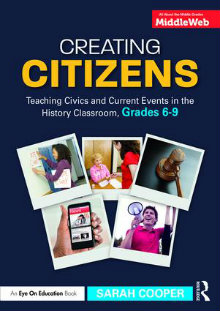Teaching Current Events in the History Classroom
Creating Citizens: Teaching Civics and Current Events in the History Classroom, Grades 6-9
By Sarah Cooper
(Routledge/MiddleWeb, 2018 – Learn more)

I loved Sarah Cooper’s first book, Making History Mine: Meaningful Connections for Grades 5-9. It was the first book I bought when I became a middle school social studies teacher, and I found it filled with great ideas and connections. So I was absolutely thrilled to be able to review her new book. And let me tell you, she did not disappoint me.

Even though Cooper’s main focus is U.S. history, her strategies are applicable to any history field or time period. I am already planning to use some of them this school year – and I teach world geography and ancient history.
Her first chapter, “Fitting Current Events into an Already-Packed History Curriculum,” gave a perfect reason for trying to actually do this. She quoted from one of her students’ reflections: “Discussing the news helps us build ties with what has come before, both in understanding themes across time and in applying cause and effect relationships to history.”
Her suggestion to incorporate new events is to teach thematically instead of chronologically, thus creating the flexibility to integrate current topics into our curriculum by tying them to those historical themes (one example – human rights).
Maintaining a non-partisan classroom
Chapter 2 addresses something that all teachers strive for, “Staying Non-Partisan and Fostering Balanced Discussions.” Cooper has developed some quick, spur-of-the-moment strategies that can assist us in modeling a civilized and academic conversation. Supporting students as they learn how to have these thoughtful discussions helps them gain a 21st century skill that will be necessary in a variety of occupations. Along with seven interventions used for the quicker debates, she provides three that come into play with topics that need more time.
To look carefully at these sensitive subjects, Cooper recommends that we specifically make sure students have access to an array of sources showcasing all sides. They should analyze these documents by listing the pros and cons of each, and after synthesizing the ideas found there, they are more ready to discuss the issues in a balanced way.
Bringing news into the classroom
More detail is given in the next chapter to her method of going about incorporating and following the news in her classroom. My two favorite suggestions involve working with the important vocabulary and the strategy she uses to illustrate what makes an article great for discussion. Briefly, this involves students categorizing the articles they bring in by looking at whether the topics are great, okay, or not so good for discussion. This sounds like a great beginning activity to set the tone for the year. She ends this section on a somber note because sometimes news is devastating, and she shares ideas to help mitigate some of the sorrow.
Primary sources are dealt with next. Here Cooper offers three approaches to help utilize these sources more deeply. One example is designing a project around the primary sources, then using the project for an assessment. She had her class write a song or poem based on the resources they found for elements of the Revolutionary War. This also tied into listening to music from “Hamilton: An American Musical” and analying some of the lyrics.
Thinking critically through op-eds
The basis for being an informed citizen is to write and speak well. Thus chapter 5 is all about “Encouraging Students to Invest in Analytical Writing.” Writing is already a given in most history classes; this section just elevates it to the level of critical thinking. For example students were assigned an op-ed piece with their choice of topic. They first read through 3 different opinion pieces in the newspaper, taking notes. Next steps involved zeroing in on a specific topic and a very helpful how-to for peer editing.
Why do we do all of this? Why is this important? The last chapter underlines the need to develop empathy and awareness of the problems and issues that surround us, while also opening the students’ minds to the possibility of further civic engagement. Cooper suggests some action points ranging from simple (showing films) to complex (developing a community impact project).
Creating Citizens is packed with fresh ideas, higher order thinking skills, and excellent tips on how to implement them. Another great resource by Sarah Cooper.
Joanne Bell is a middle school teacher at St. Joseph Elementary School in Cottleville, Missouri. She currently teaches social studies to sixth and seventh graders, but has spent most of her 35 years in the elementary grades.




































